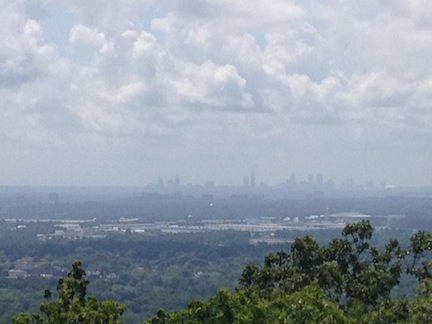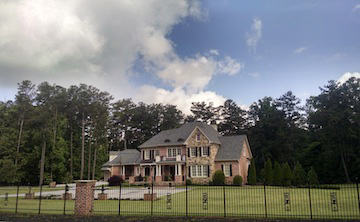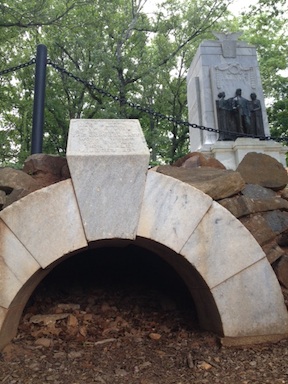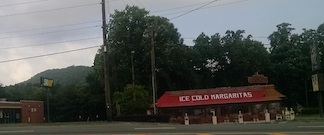Day One: Kennesaw Mountain
The first thing we notice at the base of Kennesaw Mountain is a restaurant offering “Ice cold margaritas” in big white letters across its bright red roof. In the background, Kennesaw peeks out from behind a stand of trees.
It’s 9:00 a.m., but after nine hours in the car, an ice-cold margarita might hit the spot. I spent last evening in Fredericksburg National Cemetery assisting with tours for the annual luminary program. Once the event wrapped up, my ECW pal Daniel T. Davis and my original battlefielding buddy, my daughter Stephanie, piled into the car with me for a week-long Civil War road trip. Our mission: take a ton of pictures for some upcoming ECW Series books.
 We head south on I-85 toward Atlanta. Even early on a Sunday, the city’s traffic makes angry hints at turning into something ugly. This is my first time in Atlanta, but I know it has legendarily bad traffic, so I eye the clog of cars warily.
We head south on I-85 toward Atlanta. Even early on a Sunday, the city’s traffic makes angry hints at turning into something ugly. This is my first time in Atlanta, but I know it has legendarily bad traffic, so I eye the clog of cars warily.
We get to Kennesaw Mountain National Battlefield a lot easier than the Federals did in June of 1864. Kennesaw Mountain stood as a formidable obstacle to William T. Sherman’s approach to the city, especially once Joseph Johnston’s Confederates dug in and dared Sherman to come at them. Which he did on June 27.
Dan, Steph, and I are on our way to Kennesaw to meet with historian Steve Davis, who’s going to be doing a couple projects for the book series. Steve is a tall, thin man with a shock of wispy white hair. “Steve is intense,” a friend has told us. “If you sit with him, his eyes will burn right through you!”
But Steve’s a charming Southern gentleman, too. “You’re still Yankees,” he tells us in the kindest way. “I’m still a Rebel.” He doesn’t know Dan is a native Virginian or that Steph is a Stonewall Jackson groupie.
 We take the bus up to the top of Kennesaw, and he shows us the four-gun battery that lines the razor thin crest. Off in the distance, we can see Pine Mountain, where a cannonball took apart “the Fighting Bishop,” Leonidas Polk, on June 14, 1864. In the opposite direction, we see the silver towers of Atlanta, some 20 miles away, jutting up from the sage-green distance. To the left of downtown, the hazy mound of Stone Mountain breeches along the horizon like a whale.
We take the bus up to the top of Kennesaw, and he shows us the four-gun battery that lines the razor thin crest. Off in the distance, we can see Pine Mountain, where a cannonball took apart “the Fighting Bishop,” Leonidas Polk, on June 14, 1864. In the opposite direction, we see the silver towers of Atlanta, some 20 miles away, jutting up from the sage-green distance. To the left of downtown, the hazy mound of Stone Mountain breeches along the horizon like a whale.
Steve, who has a Ph.D. in American Studies, is best known for his magnificent hardcover What the Yankees Did to Us: Sherman’s Bombardment and Wrecking of Atlanta. He also wrote the text for the Civil War Trust’s Atlanta battle app.
Steve recently retired from a career as a marketing professional with a medical malpractice firm and now he’s looking for a new project to tackle. Dan and I settle details with him for a pair of Atlanta-related books that’ll round out the ECWS nicely.
 Dan, Steph, and I also take time to explore the battlefield a little. It is not a battlefield conducive to driving. The road to the top of the mountain is closed to private vehicles on the weekends. Some of the tour stops are nondescriptly labeled on the map as “undeveloped,” a fancy word for “dirt roads and no signs.” The integrity of the battlefield is littered with home plots that are, even now, still being developed.
Dan, Steph, and I also take time to explore the battlefield a little. It is not a battlefield conducive to driving. The road to the top of the mountain is closed to private vehicles on the weekends. Some of the tour stops are nondescriptly labeled on the map as “undeveloped,” a fancy word for “dirt roads and no signs.” The integrity of the battlefield is littered with home plots that are, even now, still being developed.
Worst of all, there is literally NO parking. Kennesaw appears to be a popular destination for walkers, hikers, joggers, and dog-walkers. On one hand, it’s great to see so many people using the park—but I’ve spent nine hours in the car driving here to explore the park’s history and I can’t find a damn place to park because of all the recreational users. It would be really nice if the park reserved some spaces for people who are actually there for the park’s history, which is why the park exists as a park in the first place. Of course, the park’s website proclaims it to be “a battlefield that’s much more.” “Much more” must be another one of those clever euphemisms like “undeveloped.”
We’re nearly ready to write Kennesaw off as a loss. We have time for one more stop, though, so we decide to take a run out to the south end of the field, Cheatham Hill—named for the Confederate general, Frank Cheatham, who defended the ground. We nearly miss it because the park’s signage is so poor, but a quick left turn pulls us off the Dallas Highway and into a lush forest.
During the battle, the area was known as the “Dead Angle” because it jutted out as a salient from the main Confederate line. Federal assaults focused on the area, making it the scene of some of the battle’s most intense fighting,
We drive to the far end of Cheatham Hill Drive and park. There, we marvel at a two-gun battery housed in impressive works. A trail parallels the rest of the Confederate line, which consists of an amazingly preserved trench punctuated by parallel traverses. In the woods behind, a second line of works runs parallel to the front line.
 “Wow,” Dan keeps saying. “Wow.”
“Wow,” Dan keeps saying. “Wow.”
I walk to the end of the line, where three kids are eating a picnic lunch on a monument to Illinois soldiers. There, the Illinois men started work on a mine with the intention of blowing a hole in the Confederate line—a full month before soldiers in Petersburg tried a similar tactic.
Cheatham Hill redeems Kennesaw for us. It’s a fantastic landscape with earthworks that rival anything I’ve seen in Virginia. Dan summed it up best: “Wow.”
Our first Civil War adventure of the week is a mixed bag but, overall, a plus, particularly because Steve was such a wonderful find. The next time I do manage to sit down with a margarita, I’ll offer a toast in his honor.

I too encountered the same feeling with my first visit to Kennesaw Mountain. The drive to the top of the mountain was fraught with rush hour traffic, jogger, dog walker and hiker obstacles. It wasn’t until I arrived at Cheatham Hill and the Dead Angle that I began to see remnants of the battle (breastworks) and less of the obstacles mentioned above. Nevertheless, I still managed to get some photos on a very dreary day, some of which were used in Civil War Trust’s Hallowed Ground magazine.
https://www.flickr.com/photos/ronzo-images/sets/72157644321240339
beautiful photos!
Thanks for sharing!
I must jump in to defend this most wondrous battlefield. “Nearly ready to write Kennesaw off as a loss”?? A “mixed bag”? Chris! You surely know that battlefields do not yield their secrets so easily; they are not drive-in-drive-out affairs. Your review teaches us all the truth that a little research ahead of time will greatly enhance our battlefield experience. I am glad you made it to Cheatham Hill, ground zero of the Battle of Kennesaw. The works there are beautiful and the ground truly hallowed. But you missed several other amazing sites, such as the astounding 24-gun (Union) battery emplacements and the intricate works around Noyes Creek, which Earl Hess describes as “fascinating remnants of Rebel works with a number of unusual features, representing some of the most impressive innovations to be seen in any Civil War fieldwork system.” The intense fighting at the works on Pigeon Hill also warrant a climb. These locations require a little hiking, and the entirety of the field is spread out (after all, Sherman said the whole country was one vast fortification!). I’ve been going to Kennesaw repeatedly for years and am still discovering its riches.
Recommended reading: “Kennesaw Mountain” by Earl J. Hess (UNC Press), “The Battle of Kennesaw Mountain” by Daniel J. Vermilya (History Press), and “Clash at Kennesaw” by Russell W. Blount, Jr. (Pelican Press). Hess maps and describes the earthworks in detail; all contain beautiful, poignant details of the battle and participants.
Indeed, some advance research is useful, and we did do some. But we also operated under the assumption that we’d be able to drive around to see some things (as you can at most battlefields), but that just wasn’t really the case. It’s a battlefield best seen by foot. We just weren’t equipped for that, though.
Unfortunately, the battlefield does not seem especially “visitor friendly” to folks who are newbies or who only have a little time to visit. The place was choked with recreational visitors, which made it hard to really experience the park. For instance, there was NO parking in the lot of Pigeon Hill, so we couldn’t have climbed it even if we’d have had the time.
Knowing now what to expect, I’ll plan differently should I ever get the chance to visit again. I’m sure that’ll give me a different perspective. It’s just not a good place to “just drop in.”
I heard through the grapevine that Steve Davis is contracted to produce a couple volumes for Emerging Civil War series? I hope it is on Altanta.
Indeed, indeed! Steve is a tremendous bottle of energy, and we can’t wait to work with him!
I will agree with Amanda; the works just north of the Dallas Highway are more impressive than the works at the Angle. There are also a number of works both federal and confederate well off the beaten path that are astounding. The park is the largest green-space in the metro Atlanta area. every person in Cobb County that lives in an apartment, condo, or house with a postage stamp yard treats the place as their personal (and I emphasize personal) gymnasium. It is a little easier to get around during the late morning and early afternoon on a weekday if you have the chance to visit in the future.
Thanks for the tip, Robert. I do hope to get back to Kennesaw someday and explore in greater detail. I’ll plan for a weekday!